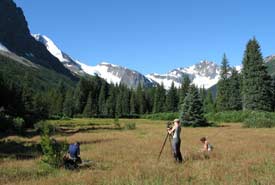Peek into the nests of some Canada’s most iconic birds
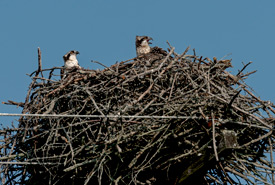
Osprey in their nest (Photo by Lorne)
Around the world, wildlife cameras have been set up in places where birds nest. The purposes of these cameras vary, but each has the ability to help viewers connect to and learn about their subjects in new ways. With live feeds often rolling 24 hours a day, the cameras provide a front-row, all-access seat to observing these species in the wild. Watch these birds in action — from laying their eggs to rearing their chicks until they are ready to leave the nest.
Explore and learn more about the bird species seen through cameras, below:
Great blue heron
The great blue heron is the largest heron found in Canada.
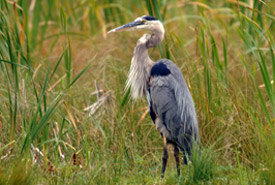
Great blue heron on shore (Photo by Karol Dabbs)
This colonial-nesting waterbird is characterized by its long neck, long legs and short tail. Its greyish-blue upper body features black and white markings on its crown and underparts.
Once hunted for their feathers, severally impacting populations, great blue herons have made a comeback across most of their historic range.
In Ontario, the Nature Conservancy of Canada's (NCC's) Minesing Wetlands provide ideal breeding grounds for great blue herons. The wetlands are home to one of the largest and oldest known colonies in the province, with more than 200 active nests.
Watch great blue herons here.
Peregrine falcon
Gaze skyward and if you notice a crow-sized, hawk-like silhouette on the edge of a high-rise building or cliff, you might just be looking at a peregrine falcon. Peregrine falcons are distinguishable from other raptors by their blue-grey back with striped underparts and slate-coloured face markings, including “sideburns.”
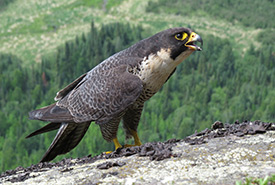
Peregrine falcon, ON (Photo by Brian Ratcliff)
The Committee on the Status of Endangered Wildlife in Canada has assessed the subspecies found on the Pacific coast as special concern, with the remainder of the population recently assessed as not at risk. The peregrine falcon population in Canada is showing an increasing trend and is currently estimated at more than 5,000 individuals. Threats to this species include habitat degradation and fragmentation, pesticides and poaching.
NCC is working to protect critical peregrine falcon habitats, such as the escarpment at the Alfred-Kelly Nature Reserve in Quebec, to ensure the birds remain undisturbed by the many hikers who visit the reserve.
Watch peregrine falcons here.
Barn owl
The characteristic pale, heart-shaped face of the barn owl easily distinguishes it from other owls.
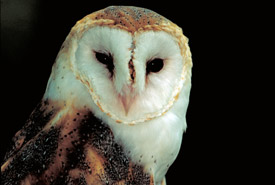
Barn owl (Photo by Dr. Thomas G. Barnes/University of Kentucky)
The barn owl can be found on all continents except Antarctica. Despite its widespread distribution, it is considered at risk in Canada. Part of this is because this year-round resident is at the northern limit of its range in the southern parts of Ontario and British Columbia. In these areas, severe winters and snow can affect prey availability. Another factor limiting the barn owl's distribution in Canada is a lack of suitable habitat.
Habitat protection is also important for barn owls, which can be found in a diverse range of habitats, from marshes and grasslands to agricultural fields and deserts. NCC is working to protect the areas where barn owls live across Canada.
Watch barn owls from Oceanside, California, here.
Osprey
This species has brown feathers with a white crown and white underparts (chest, stomach and under wings). Mature ospreys feature distinct yellow eyes with a dark-coloured pupil.
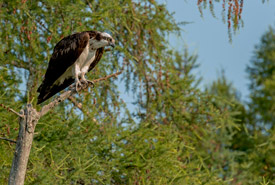
Perching osprey (Photo by Lorne)
During the summer months, Canada supports almost one third of the world’s population of this majestic raptor. Except for the high Arctic and parts of the Prairies, osprey breed across Canada. Their wintering grounds range from the southern U.S. down to South America.
Osprey feed almost exclusively on fish. They build their large, bulky nests in trees, cliffs or on artificial platforms.
Osprey, like many other raptors, suffered breeding problems due to the use of pesticides, such as DDT, in the 1950s and 1960s. However, osprey populations in Canada regained ground and have remained stable since the use of DDT stopped.
NCC is working to protect habitat for osprey on properties across Canada, including Torbay Gully Nature Reserve in Newfoundland and Labrador.
Watch ospreys in Osoyoos, BC here.

